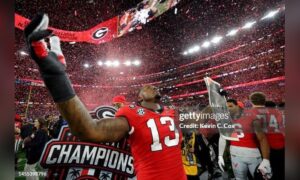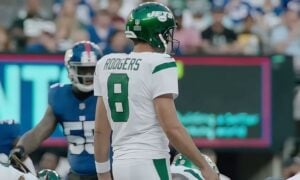By Alex Kozora
The success of the Pittsburgh Steelers wasn’t always a constant. There was a long period of time, from their inaugural 1933 season until Chuck Noll’s arrival, where the team from Pittsburgh were at worst, an utter laughingstock and at best, loveable losers.
Even during this gloomy era, there were still important figures. So for better or worse, the introduction of a new series looking back at players and coaches from 1933-1968. Some articles will be short briefs, others with more to tell. The one thing in common? They all make up the stories we have today.
Paul Moss – 1933
In 2013, the NFL collectively threw the ball over 4200 times more than they ran it. It’s a passing league, the best defense is a good offense, add your own tired cliche here.
How times have changed. In the infancy of the league, passing was an afterthought. It’s likely unfit praise to charge Paul Moss for revolutionizing the passing game, but he certainly was a pioneer in its beginning stages. For one year, the Pittsburgh Steelers – and the NFL – got to witness that.
Not much has changed in the town Moss was born in, Seelyville, Indiana. Its population sure hasn’t. Since 1910 when census records were first kept, the population has never surpassed 1400, never dipped below 800. It’s a quiet town, always has been, always will be. The Holy Rosary Church opened its doors for 104 years before its last service in 2012. There’s a small volunteer fire department. It has one stoplight. A building built in 1906 now houses a discount computer warehouse. It has character. It has history.
But alas, small towns don’t always make for big stars. The city of Terre Haute is three miles away, down Route 40, Vigo County. It’s big, always has been, always will be. Over 36,000 lived there in 1900. Today, 60,000 plus call it home. In Vigo County, it’s where you go to school and today, two schools stand. Terre Haute North and South. But they haven’t existed for 100+ years like the places in Seelyville. Terre Haute began in the fall of 1971, a product of two schools consolidating.
Gerstmeyer Technical High School was one of the two that folded under the idea a bigger school is a better one. This is where Moss could call himself an alumni. He was one of the first graduating classes from Gerstmeyer, built in 1922 and named after Dr. Charles F. Gerstmeyer, who led the charge to create a vocational school in Terre Haute. Moss graduated in 1927, near the peak of the Roaring Twenties. A time when inventions were abundant and life was prosperous.
Football was no exception. The forward pass had been legal for 21 years. In the NFL, the New York Giants’ Benny Friedman was showing the league didn’t need to exclusively be committed to the run. He tossed 20 touchdowns in 1929, an unheard of number and a feat that wouldn’t be broken until 1942. Still, the game was not conducive to the air. A football didn’t have the sleek shape it does today. Back then, it was bloated, as if someone poured Coke and Mentos inside of it. Difficult to grasp, harder to throw.
But it was Moss’ claim to fame. He earned All-State honors at Terre Haute before choosing to attend Purdue. Per his college coach Noble Kizer, Moss could do it all. In his first game as a sophomore in 1930, he caught a 15 yard touchdown pass as Purdue knocked off Baylor 20-7. He played wide receiver, defensive back, and once in 1930, had four punts land inside the opposing five. A far cry from a junior varsity performance, Mike Tomlin might remark.
In 1931, the Boilermakers went 9-1, topping off their season with a 7-0 victory over the previously unbeaten Northwestern Wildcats to a Chicago crowd of over 40,000. 1932, Moss’ final collegiate season, was his most decorated. He caught two touchdowns in the Bronx against New York University in a 34-9 rout. He ended his Purdue career with two 50 yard touchdown grabs to help defeat Indiana 25-7. Purdue enjoyed its finest season of Moss’ time, going 7-0-1, making it only the fourth time in its 122 year existence the Boilermakers went undefeated. Moss was named an All-American end.
But his biggest achievement came from the words of Grantland Rice, the most famous and well-respected sportswriter of the time (it’s who Bill Simmons‘ Grantland.com pays homage to), declaring Moss as “the finest end in football history.”
In an NFL era riddled with colorful names: Brooklyn’s Shipwreck Kelly, Green Bay’s Blood McNally, and Chicago’s Bronko Nagurski, Moss’ could be considered plain. His play was anything but. Joining the then-called Pittsburgh Pirates in 1933, he caught 13 passes for 283 yards, the latter good enough for the league lead. The wide receiver scored two of the seven touchdowns Pittsburgh would muster in their first season. In fact, the top two receiving leaders were both Pirates. Ray Tesser finished with one less yard, taking the silver medal to Moss’ gold.
But what he should be best known for professionally is being the first offensive player in Steelers’ history to find the end zone. In the team’s second game, trailing the Chicago Cardinals 13-7 with less than three minutes remaining, Moss hauled in a nine yard touchdown from quarterback Jim Tanguay. Following the extra point, and a few more ticks off the clock, the Pirates would achieve their first victory in franchise history, 14-13. Tanguay completed only five passes in his one year stint in the NFL, and the throw to Moss was his lone touchdown.
He played a large role in the Pirates other two victories in 1933. In a 17-3 win over the Cincinnati Reds, Moss is reported to have caught at least two passes for 29 yards, a fine day for the times. In an upset victory versus the Boston Redskins seventeen days later, Moss caught a 30 yard touchdown pass for the Pirates first score of the game.
These were not the glory years by any means, but it’s odd to see Moss barely register as even a footnote in the annals of Steelers’ history. Even the most comprehensive accounts of the team’s humble beginnings, detailing the arrival of sandlot players from the semi-pro J.P. Rooneys, fail to mention the collegiate All-Star.
Moss would move on from Pittsburgh in 1934 to play for the St. Louis Gunners, taking over for the defunct Reds late in the season (the details are confusing, par for the course of a league still trying to find its footing). The Gunners would defeat the Pirates twice that year, 6-0 in mid-November and 10-0 two weeks later in a game that the league would rule as an exhibition and not eligible to count in the standings. Moss would record six catches for 183 yards over three games, including a 71 yard touchdown versus the powerhouse Detroit Lions.
1934 would spell the end of Moss’ playing career, finishing with a total mark of 19 receptions,414 yards and, three touchdowns.
Football has been the main focus so far. Naturally, given this is a football site. Readership would drop dramatically if I came in and started talking about basketball. But Moss was so much more than a football player. He was a phenomenal, multi-sport athlete. In high school, he played basketball, won the 1926 Terre Haute city championship in tennis while excelling as a high jumper on the track and field team.
At Purdue, he played three sports. Aside from football, he reportedly spent time on the basketball team backing up the legendary John Wooden, though it’s worth pointing out the Purdue media guide does not list Moss on its all-time roster. What is certain is Moss played baseball for the Boilermakers in 1932, starting 11 games at second base. He led the team, hitting .419 in 43 at bats. Purdue would go on to finish the year 8-5, quite the turnaround from its 3-7 mark a year prior.
The Terre Haute Tribune Star makes a passing remark that Moss was signed by the Chicago White Sox although there doesn’t appear to be any record of him ever playing in the majors. But that doesn’t mean he never got to face off against major league talent. In August 1934, an exhibition game was set up between the St. Louis Cardinals, who would go on to win the World Series that year, and a collection of Terre Haute All-Stars, Moss included. The local celebrities were coined the “Champagne Velvets”, inspired by their sponsorship from the Terre Haute Brewing Company. The professionals were predictably victors by a large margin – 12-3 – but Moss recorded six outs in the outfield while recording one of the Velvets’ four hits.
He was an avid golfer in his post playing career and a supreme bowler, winning a city championship in his 40s. He tried his hand professionally, once carding an 801 series.
Before serving in the Navy during World War II, Moss got involved in coaching. His ability to make the game look easy on the field translated off of it, compiling a 56-19-1 record with three high schools from 1934 through 1942.
After living on a farm in Wheatland, Indiana, Moss and wife of over 40 years, Margaret, moved back to Terre Haute in the early 1970s. He was inducted into the Indiana Football Hall of Fame on April 5th, 1976.
Paul Moss passed away in his Terre Haute home on May 25, 1999 at the age of 90.
Though he was that multi-sport athlete, he would later in life remark “there wasn’t enough individualism” in college football anymore. That’s the soul of a modern day receiver.
And for his time, one of the greatest to play it.







